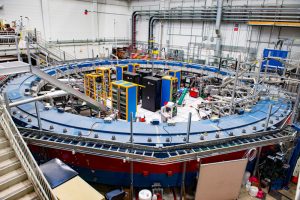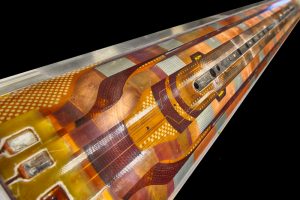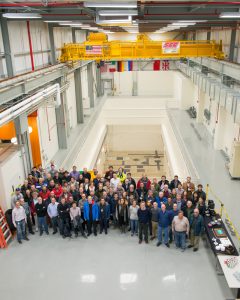
Muon g-2 is one of the Fermilab experiments that European scientists work on through the MUSE agreement. Photo: Reidar Hahn
MUSE and NEWS are two new endeavors at the DOE Office of Science’s Fermilab, the U.S.’s premier particle physics laboratory. And contrary to what some physics fans might infer, the acronyms don’t stand for science experiments.
They’re two new bridge-building grant programs that are designed to enable scientists from Europe to conduct particle physics research at Fermilab.
RISE to the occasion
MUSE and NEWS are two grant programs through which nearly 150 European scientists come to Fermilab to help advance its research, in particular on the laboratory’s muon experiments and superconducting accelerator technology. Their contributions total the equivalent of $15 million in salaried work.
The European Commission H2020 research and innovation program provides funding for the NEWS and MUSE projects through the Marie Sklodowska-Curie Research and Innovation Staff Exchange (RISE) action. (The European Commission is the executive body of the European Union.)
The RISE scheme promotes international and cross-sector collaboration through the exchange research and innovation staff and by sharing knowledge and ideas from research to market (and vice versa).
“Everybody wins,” said Simone Donati of the University of Pisa, who is also a NEWS co-coordinator. “The European institutions benefit because they receive money to travel here. Fermilab benefits because it has placed several institutions into the networks. The people benefit. And the networks should last for a long time, even after the projects’ completion.”
Building collaborations
A small group of Italian scientists who work at Fermilab started MUSE and NEWS to create more connections between the lab and the European scientific community. Employed by the Italian National Institute for Nuclear Physics (INFN), these scientists initiated the programs to foster the kind of collaboration-building that’s come to characterize the field of particle physics, where hundreds or even thousands of scientists may work together on a single experiment.
Even in cases where so many work on one project, a single person-to-person connection makes a difference.
“Programs like this keep your work open to a larger variety of scientific topics than you’d have if you didn’t have these networks,” said Fermilab scientist Emanuela Barzi, one of the NEWS co-coordinators. “Instead of sitting at your table and always doing the same thing, you engage with these networks and open your own horizons.”
Accelerating science
MUSE, which started in 2016, is coordinated by INFN researcher Simona Giovannella and supports roughly 70 scientists from universities and research institutes in Germany, Greece, Italy and the UK to work on Fermilab’s Mu2e and Muon g-2 experiments. The European scientists will contribute to an impressive 400 months’ worth of work over four years to help further the cutting-edge particle detector technologies needed to look for hidden or rare particles predicted by theory but, as of now, never observed by experiment. Fermilab scientist Doug Glenzinski coordinates this activity at the lab.
NEWS was proposed a year later, in 2016, to advance a number of fields in particle physics. Through NEWS, scientists from Germany, Greece, Italy and Sweden come to Fermilab to study muon physics and superconducting accelerator science. They also go to Caltech, NASA, SLAC National Accelerator Laboratory, and U.S. companies, as well as to the Japanese National Astronomical Observatory in Japan.
Fermilab in particular will enjoy 100 months’ worth of contributed work over four years through NEWS, beginning in 2018. The roughly 60 visiting scientists will work on superconducting technologies for particle accelerators and detectors. Barzi coordinates this activity at Fermilab.
(And in case you wondered: NEWS is short for “NEw WindowS on the universe and technological advancements from trilateral EU-US-Japan collaboration.” The MUSE acronym is more straightforward: “Muon campus in the U.S. and European contributions.” Acronymization is an art, not a science.)

NEWS enables European scientists to work on superconducting accelerator and detector technologies at Fermilab. Photo: Reidar Hahn
Reaching out through RISE
Outreach is a crucial component of participation in a RISE-funded program. MUSE and NEWS scientists at Fermilab are required to conduct science outreach in some way during their time at the lab. Many, for example, participate in the laboratory’s international summer students program, which was initially established by University of Pisa Professor Emeritus Giorgio Bellettini for visiting Italian university students in 1984.
“The summer student program is just one example,” Donati said. “There are many other initiatives that we organize at Fermilab and other institutions, such as teaching seminars by experts in their field and physics nights at historical venues.”
It’s all a part of the benefits-of-networks ethos in science, and for RISE in particular. The connections made in particle physics do more than advance research careers. They attract the next generation of scientists and benefit humanity.
“RISE says, ‘We give you money to do your excellent research, and this research must not be confined within a library or laboratory,'” Donati said. “You have to show to the public that this is important, that it’s important for society, that people in science find good jobs so that the younger generations are encouraged to pursue a career in science.”
MUSE and NEWS are just two manifestations of the principle, and Barzi expects to see a resulting expansion and strengthening of the research community.
“We’re making practical use of a European funding agency for science, expanding our funding resources,” Barzi said. “Networks tend to increase because they keep branching out and branching out. They naturally expand because you involve people who are interested in that area of science, and they kind of naturally come to you.”
She adds, “You can use your skills and knowledge to contribute outside your own narrow, specialized field. This is what I find most exciting.”
Further details about RISE work plan 2018-2020 and the upcoming call for proposals is available online.
Fermilab is America’s premier national laboratory for particle physics and accelerator research. A U.S. Department of Energy Office of Science laboratory, Fermilab is located near Chicago, Illinois, and operated under contract by the Fermi Research Alliance LLC, a joint partnership between the University of Chicago and the Universities Research Association, Inc. Visit Fermilab’s website at www.fnal.gov and follow us on Twitter at @Fermilab.
The DOE Office of Science is the single largest supporter of basic research in the physical sciences in the United States and is working to address some of the most pressing challenges of our time. For more information, please visit science.energy.gov.




